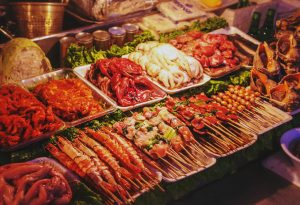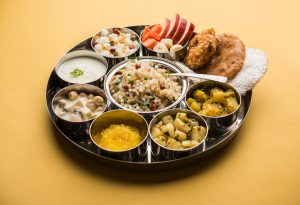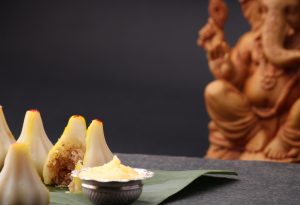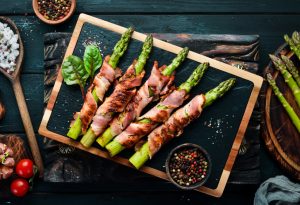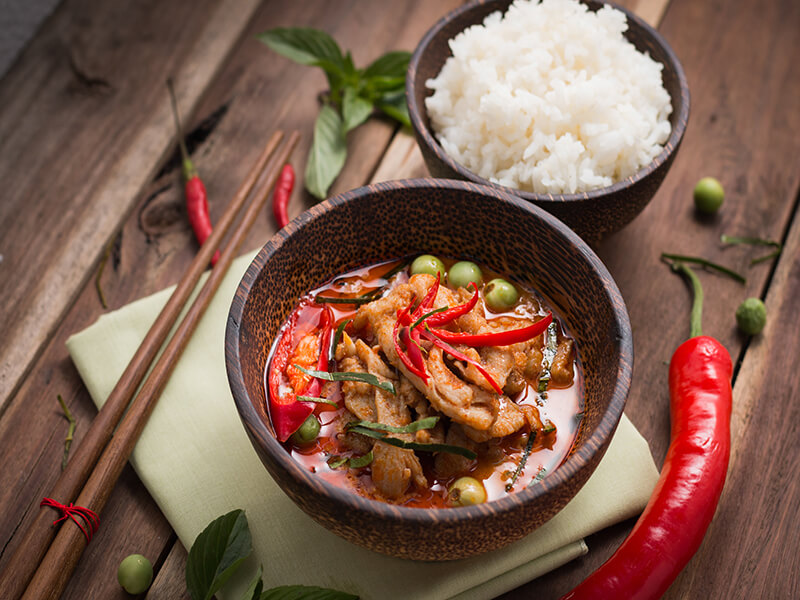
The thought of Thai cuisine brings to mind a bouquet of fresh aromas and sharp flavours, the tang of kaffir lime, the freshness of lemongrass or the heat of the spicy red chilli. The essence of Thai cuisine is a harmony of flavours. Thai food is known for its balance of the five fundamental taste senses in each dish or the overall meal: hot, sour, sweet, salty, and occasionally bitter.
Traditionally, a Thai meal is served all at once, allowing diners to enjoy complementary combinations of different tastes. A proper Thai meal should consist of a soup, a curry dish with condiments, a dip with accompanying fish and vegetables. There must be an idyllic blend of tastes and textures within individual dishes per se as also the entire meal. The ubiquitous Thai Curry can be extremely satisfying at the end of a long day. It can be put together easily and is highly nutritious as it combines all the food groups.
Red or Green Thai Curry:
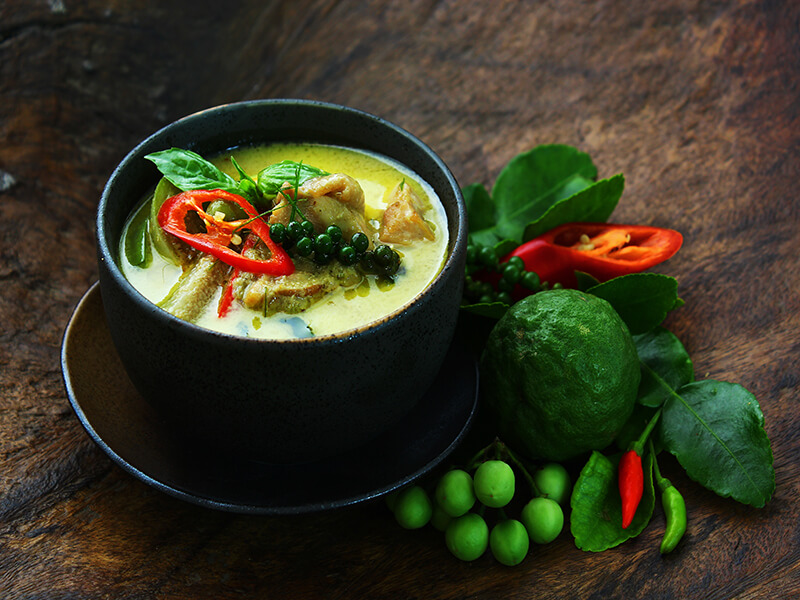
Serves: 4-6
Preparation Time: 30 minutes
Ingredients:
- 6 tbsp Curry paste (Red/Green)
- 500 g assorted vegetables (Mushrooms, babycorn, white gourd, zucchini, long beans, pak choy) – uniformly chopped
OR
- 500 g chicken or a combination of both – Chop the chicken into uniform cubes
- Handful of basil leaves
- 3-4 Thai red chillies – sliced
- 1 stick lemongrass
- 1 inch piece of Galangal – thinly sliced
- Handful of pea brinjals (optional)
- 800 ml coconut milk
Method:
- Heat a pan and add about 2 tbsp of coconut milk. Sauté about 3 tbsp of Thai curry paste in a pan with the coconut milk.
- When fragrant, add the remaining coconut milk. Allow the mixture to boil for a minute and add the cubed chicken pieces and/or vegetables and pea brinjals.
- Simmer for another 2 minutes to let the vegetables/chicken absorb the juices.
- Add some roughly shredded basil leaves, lemon grass stick and galangal and mix it well. Allow the curry to simmer for about minutes till the vegetables are cooked.
- Serve hot with steamed rice.
For a successful Thai meal, one must know Thai ingredients well and be acquainted with the art of combining flavours and textures. A note on the ingredients used.
Essential Thai Ingredients:
Lemongrass: Lemon Grass is an aromatic herb that looks like grass, smells minty and tastes similar to lemon (hence the name Lemongrass). Thai cuisine employs the thick white stem of the herb and not the leaves to add essential flavour to curries, soups and a wide variety of dishes. Try smashing a bulb and adding to stocks and the water for cooking rice or noodles for an interesting accent to the food. In India, lemongrass is added to tea and is known to cure common cold.
Makroot/ Kaffir limes and leaves: Kaffir Lime is a smaller, wild relative of the regular lime and bears a wonderful strong citrus aroma and a striking green appearance whereas the leaves, when torn, release a fresh fragrance. The rind or the zest of the lime and the leaves are used in a wide range of Thai cuisine. They come into full flavour when subjected to heat and are wonderful scented additions to Thai stir fry, curries, soups and salads. Look for fresh kaffir Limes and leaves in our exotic vegetables section.
Galangal: It is a relative of the Indian ginger but with a milder flavour and a slightly distinctive appearance. Galangal interacts well with the other essential Thai ingredients found on this page. It gives a characteristic Thai, lightly acid taste and helps reduce the smell of meat. Slices of galangal are added to many Thai curries and soups. It is widely held that crushing the bulb and boiling it in water cures indigestion or stomach upsets.
Basil: Some Thai recipes use Holy Basil (our own Tulsi) which has a clove-like taste but certain other recipes require Thai Basil or Thai Sweet Basil which is milder and sweeter. Thai Basil is used in large quantities and in many dishes in Thailand, including stir-fries, salads and soups and Thai red and green curries. It is not possible to substitute Holy basil for Thai Basil, although European Basil may be used instead. Look for them in our exotic vegetable section. They are also great added to salads and other Asian cuisines and deep fried they make a delicious wonderfully aromatic garnish.
Fish sauce: If there’s any one key ingredient that is critical to cooking Thai cuisine, it is fish sauce–for that reason alone, it’s difficult to find vegetarian recipes that actually taste like Thai cuisine. Fish sauce provides the salty dimension in Thai cuisine and is high in protein, minerals and vitamins. This is Thailand’s equivalent to soy sauce or table salt. Uncooked it has an unpleasant smell, but it adds a subtle flavour, for which there is no substitute. It can also be used to add a salty accent to other Asian cuisines.
Thai Chilli Peppers(prik kee noo): It is impossible to imagine Thai food without chillies for “spicy” is one of the words which describe Thai food the best. Chiles come in different types and sizes but the iconic chilli and perhaps the most famous ingredient in Thai cuisine is the small fresh chilli, known as prik kee noo. Although not the spiciest chilli pepper in the world, it can heat up your taste buds in good measure. Look for fresh Thai chillies in our exotic vegetable section.
Curry Pastes (kreung-geng): Curry pastes such as red, green and masaman curry pastes are made by pulverizing lemongrass, chillies, kaffir lime and other quintessential Thai ingredients. Ready-to-use curry pastes are conveniently available on our shelves. Look for Red, Green and Massaman (yellow) Thai curry paste options and use about 3 tablespoons per cup of liquid to prepare Thai curries. You may also use these exotic pastes to marinate meat and seafood before grilling for Thai flavoured starters. We also carry ready Thai Curry in cans that simply require heating up prior to serving for quick meal options.
Coconut milk: Coconut milk is used as subtle base for many Thai curries and sweet dishes. Coconut milk or ‘ga-ti’ is traditionally made by mixing the fresh grated pulp of a ripe coconut with warm water and then squeezing out the juice to obtain the rich and counters the pungency of many of the stronger ingredients. Read-to-use canned coconut milk is a convenient option. We also have Coconut cream in Organic and Lite versions on our shelves.
Jasmine rice: It is also known as “fragrant rice” and it is graded as one of the highest quality rice grains in the world. Indeed, much of this rice exported around the world is from Thailand. Jasmine rice is a long grained variety and bears a subtle, nutty flavour pleasing to the palate. Jasmine rice is available on our shelves but be sure to use it within six months of purchase for optimal flavour and freshness.

